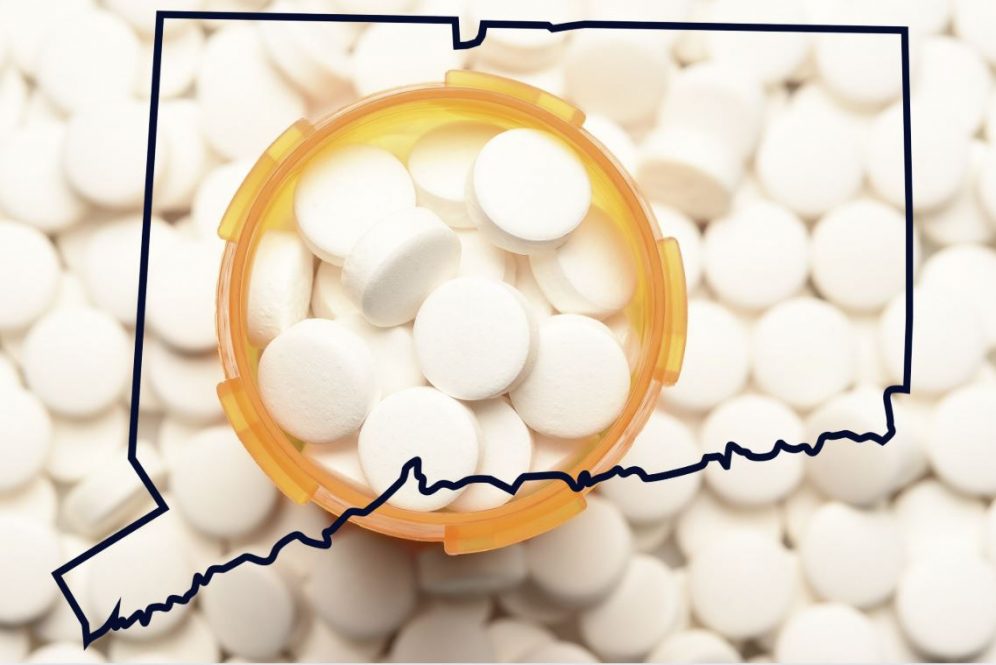Five pounds of illegal fentanyl was seized in early March in West Hartford, a town with a population of just 64,000.
“It’s scary. That’s enough fentanyl to result in many fatalities,” says UConn School of Medicine’s child and adolescent psychiatrist of the last 30 years Yifrah Kaminer MD, MBA.
Fentanyl, a synthetic opioid prescribed for severe pain and used as an anesthetic in the operating room during surgeries, when abused is 50 times more lethal than heroin.
Kaminer is Professor Emeritus of Psychiatry and Pediatrics at the UConn School of Medicine and is a researcher for the longstanding Alcohol Research Center, which focuses on advancing addiction research and care. For over five decades, it remains the longest National Institutes of Health (NIH)-funded ARC in the nation.
At UConn, Kaminer has been doing the first studies of their kind investigating fatal drug overdose trends and whether some overdoses are actually intentional acts of suicide in youth and young adults. He even has been co-investigating this public health matter among Connecticut young people with the state’s Office of the Chief Medical Examiner, with Dr. James Gill.

“It’s important that we better address this public health threat,” stresses Kaminer.
The good news is that the federal Centers for Disease Control and Prevention (CDC) in February reported a 24% national drop in U.S. overdose deaths, most likely related to the growing availability of the over-the-counter lifesaving overdose intervention naloxone.
“It’s good to see the numbers go down nationally, but we really don’t know why it’s happening,” Kaminer says. “Also, more and more new lethal drugs are entering the market. Really bad stuff, or combinations of bad drugs including veterinary sedative medications. Access to naloxone alone is not a solution to this epidemic of overdoses.”
Kaminer points out that fatal overdoses still remain the leading cause of death for Americans ages 18-44, including in Connecticut, where fentanyl overdose is to blame for 80% of death certificates for that age group.
“In Connecticut, there are now 1,000 fatal overdoses a year,” Kaminer says. “Drugs are killing more people than car crashes, suicide, and homicide, combined.”
He adds, “This is our number one public health issue in Connecticut. We need a state task force for tackling this public health crisis that is killing our youth, and more budget funding for growing substance abuse services, and also greater training for the future health care workforce.”
Parents should also take greater action now.
“Our kids are precious. We need more parents to take proactive steps to help protect their kids,” Kaminer says. “The most important prevention tool we have is parents who care, and they are in the greatest position to protect their children.”
UConn Psychiatry’s Drug Overdose Prevention Tips for Parents
- Talk to your children frequently, beginning by middle school about the dangers of ever doing drugs, how one pill laced with fentanyl can kill them, and about the risks of addiction.
- Set strong boundaries like a curfew for your children.
- Create consequences if they are caught experimenting with drugs, especially losing access to driving a car.
- Remember that some vaping, alcohol, and marijuana use are never okay for youth. Teens are impulsive and thrill-seeking, and this experimentation may be a gateway or rabbit-hole to other drug use.
- Know where your children are at all times and know their friends.
- Be aware of the suspicious warning signs of drug use like red eyes, suspicious changes in behavior, or a drop in their performance at school.
- Be aware of the warning signs of anxiety and depression, which can often lead to substance abuse in the future.
- Communicate and don’t hesitate to share with other parents including any concerns about possible drug use among your children. It takes a community to protect children.
- If your child develops signs of depression, substance abuse, or addiction, seek help for them right away. Only 10% of those with addiction ever end up getting the treatment they need.
- Never give up on protecting your child and getting them the help they need. It could save their life.
“Youth and teens need to know what you take may kill you, even drugs offered from friends, as they may be fake pills. Don’t take drugs. Prevention is key!” Kaminer says.
He also says there are three groups of kids who are higher risk of experiencing a drug overdose: The highest at risk are those with mental health issues that result in drug use, those who become addicted to opioids like fentanyl and heroin, and those who accidently encounter drugs laced with fentanyl or other deadly drugs or combinations.
The Latest UConn Research
Most recently, in February in the American Journal on Addictions, Kaminer was the lead author on a study investigating fatal overdose and suicide intentionality among young adults with opioid use disorder (OUD) in Connecticut. Kaminer studied 33 patients aged 18-26 with opioid addiction in methadone treatment. Forty-two percent of these patients had a history of a suicide attempt, 78% of which reported more than one intentional overdose. These individuals also had higher depression severity and also started taking opioids at a younger age. He found there was a high prevalence of intentional overdose among young adults, even those enrolled in getting help in clinical services. He found an uptick in fatal overdoses fueled by fentanyl and other synthetic opioids, along with the growing availability of opioids contributing to the increase in youth suicide rates since 2007.
Also, previously in the same journal, Kaminer was first to examine Connecticut’s trends and increasing rates of intentional fatal overdoses with fentanyl among youth using the data from the state’s Office of the Chief Medical Examiner between 2019-2021. There was a significant increase during this time period of fatal overdoses attributed to fentanyl with most involving individuals 20-25 years old, but 10% were in the younger ages of 15-19, and for the first time fatal overdoes were detected among 10–14-year-olds. He found that intentional fatal drug overdoses doubled from 2016-2018’s rate of 3.8% to increase to 7.7% during 2019-2021.
“Suicide intentionality is more prevalent in those who overdose. We must increase awareness to parents and also young people of the dangers,” says Kaminer, adding that teens, especially those 15-16 years old, are at an age when impulsivity and experimentation reaches its peak.
“Ten percent in our study of overdoses are actually suicide,” says Kaminer of the Connecticut research, with even higher numbers elsewhere. Importantly, he also points out the dangers of repeat drug overdose. When someone overdoses on drugs like fentanyl they experience reduced stimulation of their brain, stop breathing, and do not get the proper blood and oxygen. Even if they are resuscitated successfully and survive there is some brain damage. Many people who overdose more than once may be experiencing compounding, continuous brain damage.
“Desperate times call for desperate measures to save lives,” says Kaminer, who has raised the idea for examining a “Civil Commitment” to a supervised clinical environment for individuals with repeated drug overdose history, similar to what can be done following a suicide attempt. “The discussion will have to balance the right for personal autonomy with implementing immediate high-risk safety considerations.”
Kaminer often works with the Root Foundation in Connecticut to perform his addiction study research, which has free care clinics across the state to provide treatment and medications like methadone for youth suffering from opioid use disorders. But, he says, Connecticut needs more services.
“There are not enough treatments or treatment beds available for substance abuse care currently,” Kaminer says, most likely due to no or lower insurance reimbursement rates for care.
“We need to extend services, we need more clinical research, and larger studies,” Kaminer says.
Federally Funded Free Treatment Study at UConn
To increase access and research, Kaminer and UConn School of Medicine is collaborating with Mass General Hospital and Harvard for a federally-fund study treating young people ages 14-21 with substance abuse disorder.
“Our study is a win-win offering high quality treatment free of charge to youth in need whether in-person or virtually,” he says about the program which offers free outpatient treatment and psychotherapy to youth who are abusing alcohol or substances like marijuana.
“Please spread the word of our free program to local youth who may benefit from our free, highly effective research treatment for alcohol and/or substance use, including marijuana, whether ranging from occasional use to heavy use,” shares Kaminer.
Kaminer also volunteers to provide free educational presentations to schools or organizations at no cost.
“We need to remove the stigma of drug addiction,” he says. “It is a health disorder, and we need to deal with it and make it a top priority to get more people, especially our young people, the help they need now and to save their lives.”



